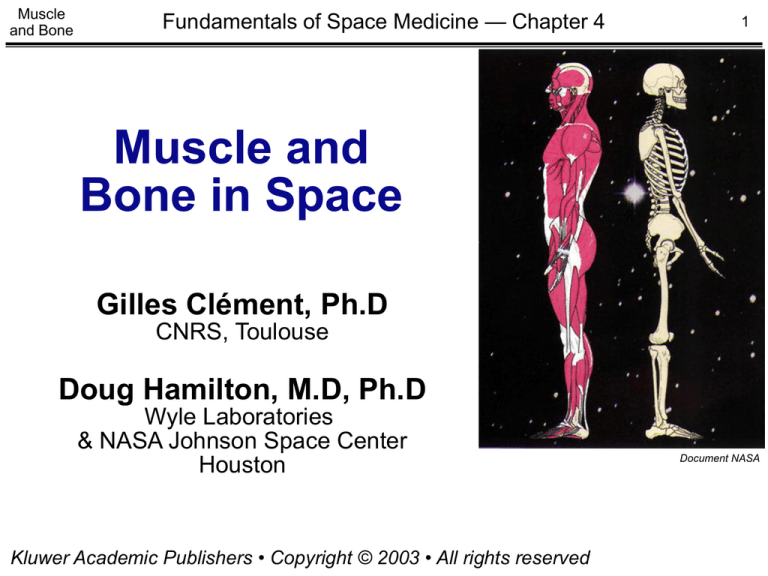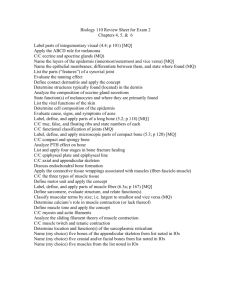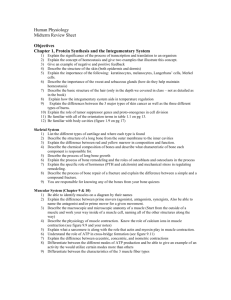
Muscle
and Bone
Fundamentals of Space Medicine — Chapter 4
1
Muscle and
Bone in Space
Gilles Clément, Ph.D
CNRS, Toulouse
Doug Hamilton, M.D, Ph.D
Wyle Laboratories
& NASA Johnson Space Center
Houston
Kluwer Academic Publishers • Copyright © 2003 • All rights reserved
Document NASA
Muscle
and Bone
Key Concepts
• Principles of normal muscle and bone
function on Earth
• Pathology of muscle (atrophy) and bone
(osteoporosis)
• Effects of spaceflight on muscle and bone
function and their functional significance
• What (if any) countermeasures can be used
2
Muscle
and Bone
Muscle Physiology
• Skeletal muscle is the largest tissue in the body,
accounting for 40-45% of the total body weight
• Each end of a skeletal muscle is attached to a bone by
tendons. Skeletal muscles work in pairs: one muscle
contracts to pull a bone forward, the other to pull it back
• Contractions of skeletal
muscles are coordinated
by the brain
• The antigravity muscles,
also known as postural
muscles, owe their
importance and strength
to the presence of gravity
3
Muscle
and Bone
The Engines of the Muscle
• Muscles are composed of fibers
• Each fiber is made up of myofibrils,
consisting of many filaments (myosin
and actin), the engines of the muscle
• Together, the actin and myosin
provide all the muscle’s movement
and force as they slide together
(contraction) and apart (during
relaxation)
• In healthy muscles, there is a
continual process of muscle
protein production and breakdown
• When protein breakdown occurs
more rapidly than protein production,
there is a loss of muscle mass
4
Muscle
and Bone
Muscle Contraction
• Contraction refers to the
active process of generating
a force in a muscle
• The force exerted by a
contracting muscle on an
object is the muscle tension
• The force exerted on a
muscle by the weight of an
object is the load
• When a muscle shortens and
lift a load, the muscle
contraction is isotonic
(constant tension)
• When shortening is prevented by a load that is greater than
muscle tension, the muscle contraction is isometric
(constant length)
5
Muscle
and Bone
Energy for Muscle Contraction
6
• Basic source is Adenosine Tri-Phosphate or ATP
• The amount of ATP present in the muscle cells is only sufficient
•
to sustain maximal muscle power for 5-6 seconds
New ATP must be formed continuously:
– creatine phosphate: can sustain 10-15 more sec of muscle activity
– anaerobic step of glucose breakdown: for another 30-40 sec
“bursts” of energy
– aerobic system: provides unlimited time muscle activity (as
long as nutrients last)
creatine phosphate
ADP+Pi
Myosin ATPase
creatine
ATP
protein
glycogen
glucose
GLYCOLISIS
lactic acid
oxygen
OXIDATIVE
PHOSPOHORYLATION
fat
Contraction
Muscle
and Bone
Muscle Activity
• The filament’s force is all or nothing. When called upon, it
always applies the same amount of force at the same speed
• There are 2 kinds of muscle fibers :
– Type I, or “slow twitch”, are slow moving but high-stamina
fibers. Use oxygen. Marathon runners typically develop those
in the soleus muscle in the calf for prolonged lower leg
muscle activity
– Type II, or “fast twitch”, are high-speed, high-output fibers.
Sprinters and weight-lifters typically develop those in the
gastocnemius muscle in the calf and in the biceps muscle for
quick, powerful “bursts” of movement. They fatigue rapidly
(use glycogen rather than oxygen).
• The average person has about 50%-50% of Type I and Type II
fibers throughout the body
7
Muscle
and Bone
Muscular Exercise
8
• Strength and endurance can be increased by
exercise (training)
• Capacity of a muscle for activity can be altered:
– by transformation of one type of fiber to
another: e.g., muscle required to perform
endurance-type activity will develop more
Type I fibers and number of blood capillaries
will increase
– by the growth in size (hypertrophy) of the
muscles fibers: e.g., weightlifting will induced
hypertrophy in Type II fibers, with an increase
in synthesis of actin and myosin filaments
• Endurance exercise also produces changes in
the respiratory and circulatory systems, which
improves the delivery of oxygen and nutrients to
the muscle fibers
Photo NASA
Muscle
and Bone
Muscle Atrophy
• Denervation atrophy: If the nerve fibers to a muscle are
severed or the motor neurons destroyed, the denervated muscle
fibers become progressively smaller, their content of actin and
myosin decreases, and connective tissue prolifers around the
muscle fibers
• Disuse atrophy: A muscle can also atrophy with its nerve supply
intact if it is not used for a long period of time
• Atrophy occurs when muscle can not breakdown ATP as fast
Adapted from Lujan and White (1994)
9
Muscle
and Bone
Effects of Spaceflight on Muscle
• Decrease in body mass
• Decrease in leg volume
10
Document NASA
Movie:
10_scale
Skylab 4
Skylab 2
Skylab 3
Movie:
10_legvolume
Muscle
and Bone
Effects of Spaceflight on Muscle
• Decrease in body mass
• Decrease in leg volume
• Atrophy of the antigravity muscles (thigh, calf)
– decrease in leg strength
– extensor muscles more affected than flexor muscles
• Data in flown rats showed an increase in number of Type II,
Photo NASA
“fast twitch” muscle fibers (those which are useful for quick
body movements but more prone to fatigue)
Ground control
Flight
11
Muscle
and Bone
Muscle Atrophy Countermeasures
• 2 daily one-hour sessions of exercise:
– Treadmill with axial loading
– Cycle ergometer
– Interim resistive exercise device
– Traction on “bungee cords”
• 4-day cycle:
– Day 1, low load but high intensity
Documents NASA
– Day 2, moderate load at moderate intensity
– Day 3, high load low intensity
– Day 4, ad lib
• "Penguin Suit" contains a
system of elastic, straps,
and buckles that can be
used to adjust the fit and
tension of the suit
Movie:
12_bungee
12
Muscle
and Bone
Muscle Atrophy—Challenges
• Exercise alone has not prevented muscle atrophy during
spaceflight
• The increase in fast-switch fibers could result in a higher
susceptibility to contraction damage (sprain)
• Muscle atrophy caused by weightlessness participates in
postural instability and locomotion difficulties after
spaceflight
• Astronauts data are complicated by prior physical fitness and
in-flight exercise countermeasures or work loads (e.g., EVA)
• Muscle development was disrupted when gravity-loading
exercise was removed from immature rats flown on Neurolab
• The muscle weakness, fatigue, faulty coordination, and muscle
soreness that astronauts experience after spaceflight mimics
the changes seen in bed-rest patients and the elderly
13
Muscle
and Bone
Function of Bone
• Structural organ
– Weight bearing bones: support and make the body mobile
(spine, skeleton)
– Protective bones: shield our delicate internal organs
(skull, ribs)
• Mineral reservoir
– Life began in a primordial sea rich in potassium and
magnesium and poor in sodium and calcium
– With time, geological changes altered the composition to
one which is rich in sodium and calcium
– As organisms became multicellular they needed to also
control their extracellular milieu
– An adult contains approximately 1000 grams of calcium:
• 99% in the skeleton
• 1% in the extracellular space and soft tissues
14
Muscle
and Bone
Weight-Bearing Bones
• The antigravity bones are responsible for bearing the weight of
the body in a gravitational environment
• Trade-off between excessive mass versus fragility (e.g., bear
has heavy bone, reduced mobility; bird has light bone for flying)
• Natural selection gives minimum structure
15
Muscle
and Bone
Bone Remodeling
16
• Bone tissue is remodeled every 5 months by :
– Activation (stress)
– Resorption (osteoclasts) 3 weeks
Osteoclasts = crushers
– Formation (osteoblasts) >4 months
Osteoblasts = builders
Muscle
and Bone
Calcium Balance
17
Blood
Absorption
0.3-0.5 g
Diet
0.5-1.5 g
Secretion
0.3-0.5 g
Bone
Filtration
5-7 g
Reabsorption
4.9-6.7 g
Intestine
Urine
0.15-0.3 g
Feces
0.35-0.6 g
Kidney
Muscle
and Bone
Osteoporosis on Earth
• On Earth, osteoporosis is a bone disease in which the bone
mass is reduced by 0.5-2.0% per year
• Approximately 500.000 hip fractures secondary to osteoporosis
occur annually in the U.S.
• By age 80, 25% of women and 15% of men will suffer a hip
fracture. 10% of these patients will die as a result of this fracture
• The hospital care costs for these patients will reach 5 billion
Document MEDES
dollars annually. The cost from non-hospital care facilities is
an order of magnitude greater
18
Muscle
and Bone
Bone Loss during Spaceflight
• Vostok: Increased fecal and urinary calcium first noticed
• Gemini: Loss of approximately 2-4% of bone mass in
heel after 4-11 days of spaceflight
•
•
•
•
Apollo:
3-5% decrease in bone mass after 10 days
Soyuz:
8-10% decrease in bone density
Skylab: 1-3% per month loss in bone mineral
Mir:
10% loss of trabecular bone from lumbar spine in
one cosmonaut after a 1-year mission
• Shuttle-Mir:
– With countermeasures: 5.4% decrease in bone density in
tibia. Did not return to preflight level in some individuals
– Without countermeasures: 1.3-1.5% per month decrease in
bone density (worst case: 15-22% total in some bones)
• ISS:
Preliminary data similar to Shuttle-Mir
19
Muscle
and Bone
Bone Loss during Spaceflight
Postflight changes in bone density compared to preflight
20
Muscle
and Bone
Calcium Loss during Spaceflight
Compiled data from Gemini 7, Skylab 2-4, and Shuttle missions
(each data point represents the mean ± SD of n= 2 to14 subjects)
21
Bone Loss during a Mars Mission
Adapted from National Geographic, January 2001
Muscle
and Bone
During a mission to Mars, a 45-year-old astronaut could see bone
deterioration reach the weakened state of severe osteoporosis
22
Muscle
and Bone
Bone Loss Countermeasures
• Mechanical loads causes slight deformation called strain
– Bone length changes of 0.1% correspond to 1,000 microstrain
– Mechanical strain above an upper limit will provoke adaptive
remodeling to increase bone mass. Mechanical strain below
a lower limit will generate a reduction in bone mass
• Vibrations have been proposed as a way to stimulate strain:
– Animals were placed on a vibrating platform (0.3 g, 30 Hz)
– After a year of daily 20-minute sessions, a sheep showed
the robust striations of increased density (lower right).
Control sheep showed normal bone (lower left)
23
Muscle
and Bone
Bone Loss—Challenges
• Bone loss during spaceflight is about 1-3% per month.
What will be the new state for bone after very long missions?
• What is the fracture risk
for such changes in
bone density and
structure ?
• Risk of renal (kidney)
stone formation
• Will reduced Mars gravity
be enough for preventing
further bone loss ?
• How should bones be
loaded in reduced gravity ?
• Which countermeasure (mechanical loading, exercise,diet,
drugs, artificial gravity) work best ?
24
Muscle
and Bone
Muscle and Bone Summary
• Muscle
– Decrease in leg muscle size
and strength
– Increase in number of
“fast twitch” muscle fibers
• Bone
– Continuous decrease in bone
mass and density
– Fracture risk probably increases after long-duration flight
• Experience of long-duration missions indicates that current
in-flight countermeasures are not optimal
• Using the current counter-measures methods, humans would
not be operational just after landing on Mars
• Is Mars gravity sufficient for regaining normal muscle and
bone function ?
25
Muscle
and Bone
Additional Reading
• Clément G (2003) Fundamentals of Space Medicine. Dordrecht:
Kluwer Academic Publishers
• Johnston RS, Dietlein LF (1977) Biomedical Results from Skylab.
Chapter 21. Muscular deconditioning and its prevention in space
flight. NASA SP-377, Washington DC: NASA
• Long ME (2001) Surviving space. National Geographic, January
• Rittweger J, Gunga HC, Felsenberg D, Kirsch KA (1999) Muscle and
bone—Aging and space. J Gravitat Physiol 6: 133-135
• Integrative Physiology in Space. European J Physiol 441, Number
2-3, (Supplement), 2000
• International Workshop on Bone Research in Space. Bone, Official
Journal of the International Bone and Mineral Society, Volume 22,
Number 5 (Supplement), 1999
• Muscle Research in Space: International Workshop. International
Journal of Sports Medicine, Vol 18 (Supplement 4): 255-334, 1997
• NASA Critical Path Roadmap at http://criticalpath.jsc.nasa.gov/
26









